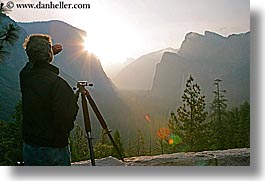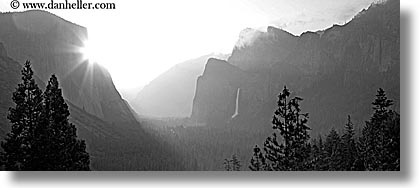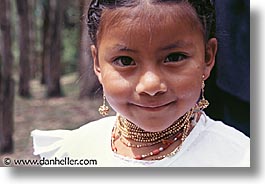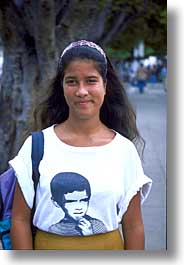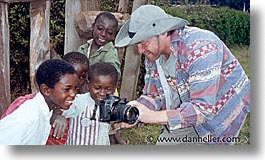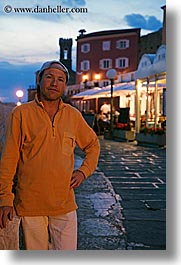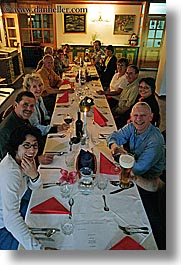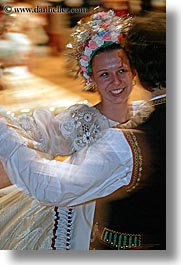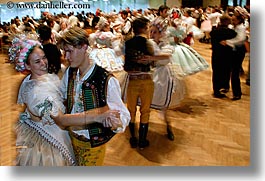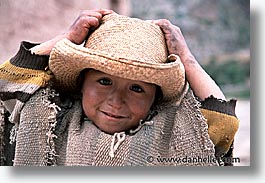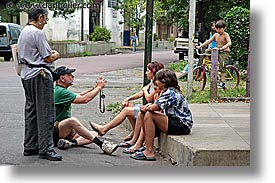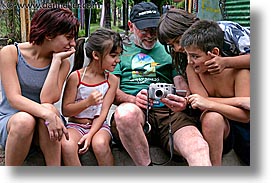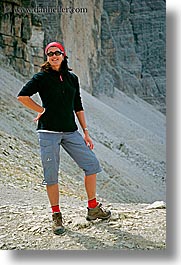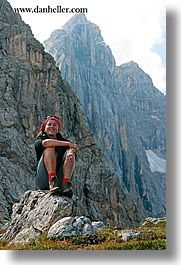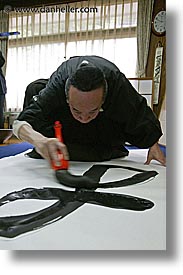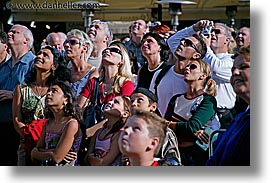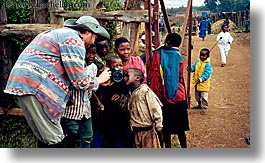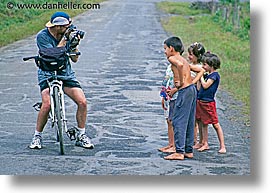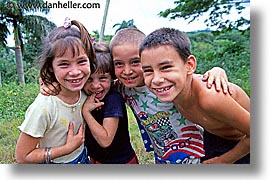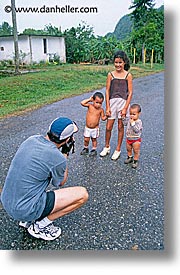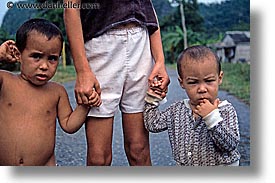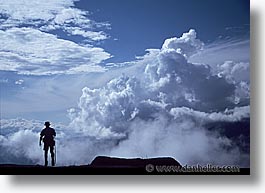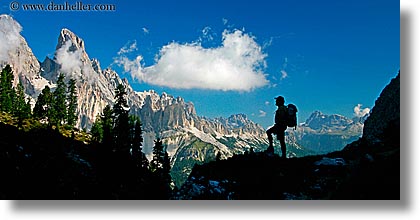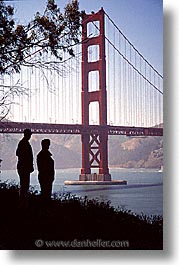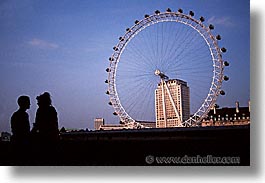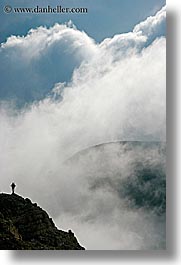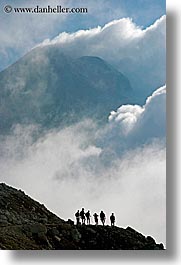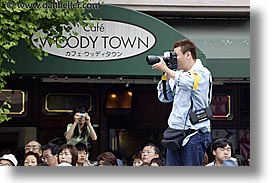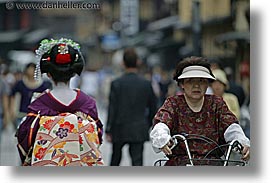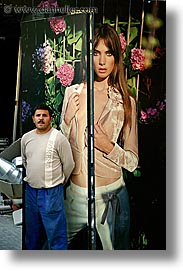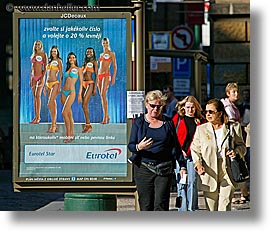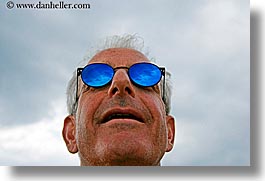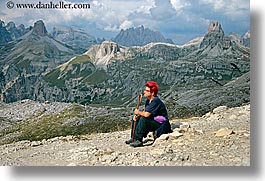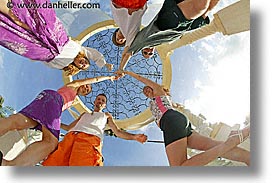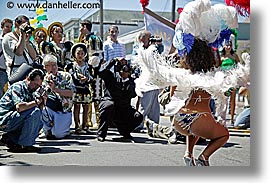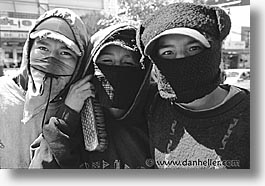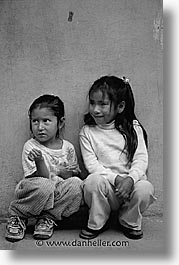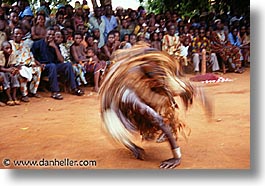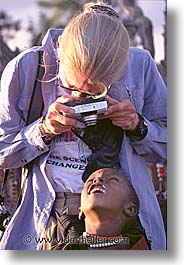|
Click to recommend this page:
| |
 Introduction
Introduction
The word "snapshot" was coined in the 1800s by a man who returned from
hunting birds. He proclaimed that his poor yield was due to his shots
being fired quickly, without deliberation. "They were snap-shots," he
declared dryly. The term never stuck in the hunting world, but it was
later applied to photography and hasn't changed its meaning since.
Like the hunter who coined the phrase due to his lack of good bird yield,
photo "snapshots" will not yield many good photographs either.
Perhaps this is most applicable to photographing people, since a "snapshot"
implies "without intent," and good pictures of people are those that
exhibit something about the person that touches us somehow. This is best
done with deliberate intent. Without it, you'll end up with a pretty
mediocre series. Whether you're looking to shoot magazine-style pictures
of native peoples from foreign countries, decked out in their traditional
clothing, or lovers embracing in San Marco Square in Venice, you'll find
that the most challenging part of photographing people is less about
technique as it is about understanding people. And that's where intent
comes into play.
 Two Steps to Developing Intent
Two Steps to Developing Intent
People often associate photography with the skill of taking a photo
just at the right time to capture what appears to be an arbitrary—but
meaningful—moment in time. This is often deceptive to the common
viewer because they often attribute the photographer as being lucky.
"You shoot a zillion shots, and one of them is bound to be good."
That's true, but it isn't till you've shot zillions of zillions do you
find that your yield of "good" pictures starts to improve. This is because
at some point along the way, you realize that it requires getting closer
to your subjects, both figuratively and literally. Once you achieve this,
you begin to develop the second step of developing intent: refining the
kinds of pictures you like, and trying to repeatedly get those kind of
shots with each successive trip.
To some, a candid "grab" shot is the same as a "snapshot", but it is
entirely different. Though a "grab-shot" may be taken quickly, it's quality
is measured by its emotional impact on the viewer: a facial expression,
the subject's juxtaposition with the background, his interaction with
the environment or other people. This is the direct result of intent.
By comparison, a snapshot usually lacks these features, and instead has
lots of wasted space (parts that don't contribute to the image somehow),
poor composition, or worst of all, a yawning viewer.
   Step 1: Get out of Tourist Mode
Step 1: Get out of Tourist Mode
When traveling, you often find yourself in unfamiliar environments,
so you may not necessarily understand how you will be perceived by
the people you're trying to photograph. Many people handle this very
differently. Some either barge forward, taking pictures as if their
subjects were animals in a zoo, or they hesitate at the camera's shutter
button, concerned that they are invading the subjects' space, or violating
their privacy. Will they take offense? Do some really believe that
having their photo taken will steal their spirits? Should you ask for
permission first? Should you pay them for taking their picture?
When it comes to getting good pictures of people, the primary problem
people have is being in a tourist frame of mind. As long as you
consider yourself an outsider, you'll be treated as one, and there will
be a distance that will be discernible in your photos. To remedy this,
you need to establish a rapport with your subjects. Be interested in
them. Communicate with them. You want a photo that reflects who they are,
how they feel, and what their life is like in their own environment. If
you join them in their space, you won't feel like you're invading it
(and neither will they). This doesn't have to take any time at all—often
it's little more than a physical disposition you exhibit in their
presence. Sometimes, it's a word spoken, or small talk. Again, it's a
"frame of mind" that's communicated with your behaviors.
 A Story
A Story
When on a photo workshop in Cuba, I was working with a student who wanted
to be a travel photographer. Her portfolio had great scenic pictures, but
she had no people pictures. She said she never really got good pictures
of people, so she doesn't show them. When we were out shooting, I could
see why: she wouldn't approach anyone, or even bother to "grab-shoot"
in open squares or forums, a technique that pro travel photographers
and photo-journalists employ. When asked why she didn't take pictures of
people, she gave the old stock answers: "I don't want to bother them,"
"They don't want their picture taken," and "They wouldn't let me."
I wasn't having any of these problems. In fact, Cuba has got to be the
easiest place in the world to photograph; the people are friendly, very
photogenic, and will sometimes demand that you take their pictures if
they see you walking by. As it happened, a girl walked by that caught my
photo student's attention. "I'd really wanted to get a picture of her",
she said, as we both watched the girl walk by. I said, "Ok, if you're
uncomfortable shooting from a distance, just go up to her and ask." The
student hemmed and hawed, partially because the language barrier made
it intimidating for her to attempt contact. With a little nudging, I got
her to approach the girl, but she quickly backed off and said, "See,
she doesn't want her picture taken."
It was clear that the student simply didn't understand what it really
means to approach someone. In this case, it was rather simple—I just
walked up to the girl and said, "Hola!" (a common Spanish greeting). She
looked and smiled, and then I made a few gestures about her t-shirt
("Elián Gonzaoles!", I'd say). She'd nod affirmatively. And then I
pointed to her shirt and then my camera and I asked, "photo?" She smiled
and said "Sí," and I took the picture shown here. Not a good
picture by any means, but the point was to demonstrate that people can
be comfortable with your taking their picture if you handle it properly.
 The Lessons:
The Lessons:
First and foremost, don't be afraid. This often starts with friendly eye
contact and a disarming smile. You should downplay your photographic
intentions—swing your camera around your back, and approach people
as if you don't have any intention on taking their picture. Instead,
talk to them. Even if you don't know their language, a few known words or
even attempted gestures often gets you 90% of your way there. Once you
establish yourself as comfortable in their environment, they will be
comfortable with you. If at this point, you want to take some pictures,
you'll have a much more receptive audience.
Children are often the best subjects, since they're fun, cute, lively,
and (usually) innocent. While children vary greatly from different
areas of the world, one of the most common hurdles you need to clear
is their apprehension to you—or, strangers in general. It's not so much
that they don't want to be photographed—it's more an generic response.
Your camera will only intensify that fear if you barge right up with it
in their faces.
For the most apprehensive, I've found the easiest thing to do is let
them look through the camera. They'll laugh and scream and compete
with each other to get a good look or two. You can even let them take
pictures of each other, although this will surely result in a lot of time
expensed. (With digital cameras, be prepared to preview a lot of photos!)
Suddenly, the game changes from "keep away from the photographer," to
"who gets to see through the view-finder." Before you know it, they all
want to be in the picture. And, when the "flash" goes off, be ready
for screams of excitement and enthusiasm. They may never let you go home.
 Step 2: Developing Techniques
Step 2: Developing Techniques
Once you've gotten comfortable with the process of getting to know your
subjects, the next step is to develop an eye for what kind of pictures
you like. This step is often thought of as two parts as well: the
artistic side, and the technical side. Developing taste is a matter
beyond the scope of this book, since that's something that is more about
the heart than the mind. People have been known to pay large sums of
money for what most of us (OK, "I") would consider "bad art," so I
don't want to get too close to that subject. But, what I can do is help
you with some basic checklist items for improving your technique:
 Proper use of a flash
Proper use of a flash
A flash can work for you or against you! It's important to understand
these basic facts:
 A Flash is largely ineffective beyond 10 feet. A Flash is largely ineffective beyond 10 feet.
 Avoid use a flash as your main light source, like in a dark room.
People will be overexposed, and you'll rarely see the background. Avoid use a flash as your main light source, like in a dark room.
People will be overexposed, and you'll rarely see the background.
 Use flash in midday light to brighten dark shadows Use flash in midday light to brighten dark shadows
 For night photography, turn off your flash and increase your ISO setting. For night photography, turn off your flash and increase your ISO setting.
 If you have to use a flash, reduce its power by up to "1 stop" to
avoid the "bursty" look. If you have to use a flash, reduce its power by up to "1 stop" to
avoid the "bursty" look.
 Use the flash to "freeze the frame" in action/motion.
Using a flash along with a slower shutter speed (1/8 to 1/10 second) during
fast-motion activities is a good way to freeze the action to capture the
faces, while also allowing the motion blur from the longer exposure to
emphasize the movement. Use the flash to "freeze the frame" in action/motion.
Using a flash along with a slower shutter speed (1/8 to 1/10 second) during
fast-motion activities is a good way to freeze the action to capture the
faces, while also allowing the motion blur from the longer exposure to
emphasize the movement.
 See Photography equipment for travel, including cameras, film, lenses, etc. for detailed information on using a flash. See Photography equipment for travel, including cameras, film, lenses, etc. for detailed information on using a flash.
 Experiment with different lenses
Experiment with different lenses
Zooming up close is great, but other kinds of lenses can yield great
effects you wouldn't expect.
 Preview your pictures with your subject so they feel part of the process
Preview your pictures with your subject so they feel part of the process
Nothing embraces people more than their seeing themselves on your camera's
preview screen. Almost instantly, people's objections to having their
pictures taken are replaced by enthusiasm and eagerness. Take pictures of
others (even your own travel companions) and show your intended subject
the preview screen, and you'll have a new friend for life.
 Choose your background
Choose your background
An "inventory picture" is one you take to prove you were there. A "good
picture" is one that gives your subject a more accurate sense of place.
Pay attention to what's around you to give information about where you are.
 Capture People Engaged in Activity
Capture People Engaged in Activity
It's nice when your friends look at the camera and pose, but
when people are engaged in an activity, photos become more interesting.
A photo of someone you don't know doesn't mean much unless there's
something about them that explains who they are, or what they do.
 Make the activity a prominent part of the picture, or the meaning gets lost. Make the activity a prominent part of the picture, or the meaning gets lost.
 When shooting portraits of artists, workers, gardeners, etc., incorporate their craft into the picture. When shooting portraits of artists, workers, gardeners, etc., incorporate their craft into the picture.
Photographing Children is the easiest and best way to get a ton of
good, fun, people pictures. However, the challenge can be similar
to herding cats, especially if you don't speak the language.
Children in heavily populated tourist spots in foreign countries often
become jaded to the rudeness of tourists who lunge at them with their
cameras. When faced with this situation, the easiest way to introduce the
idea of taking pictures, is to let them look through the camera first.
In fact, I let them take pictures of me before I photograph them.
Most people shoot while standing in an upright position. Normally,
this gives your perspective on the world. When photographing children,
this always makes them look small, they're always looking up (or you
can't see their faces), and you usually only see the ground behind them.
The first rule of thumb is to be at eye level with children. So, stoop!
In these two sets of pictures, the first of each pair shows how I'm
photographing the kids. Note how close I get. I am using a 135mm zoom
lens to get even closer. The result is shown in the second picture.
One way to make a person really stand out, even when they take up a
very small part of the scene, is to cut them out into a silhouette.
When a dark human shape punctuates through a bright scene, it not
only draws attention to the vastness of the landscape, but underscores
one's personal relationship to it. Meter on the bright areas of
the scene, not the person himself.
A couple silhouetted makes for intimacy or romance, even if none is
actually going on.
Another aspect to consider is the "power of one." A single individual
tends to have a more dramatic effect than a group. Although both are
good—I never shy away from any silhouette—the visual impact of a
solitary figure is worth spending extra effort to get.
The juxtaposition of the subject to the environment can be funny,
scary, profound, or disturbing. When my funny bone itches, I try to
place people next to things that are either completely opposite, or
at least, unexpected.
Creative use of color can range from scenes with lots of it, to very little.
When a single, bright color punctuates through muted tones, it draws
attention.
Don't forget the age-old beauty of black and white. With digital cameras,
any photo can be quickly converted to B&W with a simple click of the
mouse using any image editing software, or photo-printing site.
Many cameras today also offer various B&W options as shooting modes.
   Shooting from Different Angles
Shooting from Different Angles
Tired of the same old portraits? The quickest way to get out of
a photo rut is by changing your camera angle. Here are some suggestions
for spicing up your photos if you've lost your motivation:
 Get down on the ground and shoot at the lowest point you can.
Horizontally, or straight up—you'd be surprised how the world opens up. Get down on the ground and shoot at the lowest point you can.
Horizontally, or straight up—you'd be surprised how the world opens up.
 Reach high, or better yet, climb stairs.
Get to a high vantage point, and shoot down on streets or crowds of people. Reach high, or better yet, climb stairs.
Get to a high vantage point, and shoot down on streets or crowds of people.
 Use unconventional lenses.
Using a telephoto in a crowd gets to to think close-up portraits.
Super-wide angles get you to think in terms of new compositions.
A fish-eye lens allows you to see the humor in things. Use unconventional lenses.
Using a telephoto in a crowd gets to to think close-up portraits.
Super-wide angles get you to think in terms of new compositions.
A fish-eye lens allows you to see the humor in things.
 Find objects that can be used to "frame" subjects. Find objects that can be used to "frame" subjects.
For each of these new angles, you might be thinking: how do you look
through the viewfinder when you're holding the camera high up, or
when your down on the ground? The answer: I don't. Just start shooting
and review photos later for the best ones.
 Payment for Photography
Payment for Photography
Anyone that travels frequently will invariably run into basic textbook
social issues with photography. Most common is the confrontation
you may have with people who demand that you pay them to take their
pictures. This usually happens in poorer third-world countries or
pockets of poverty in developed countries. When money is scarce, any
means of income is sought, and tourism is often the best and easiest
source for money for the least amount of effort. Although there are the
clear economic benefits tourism brings to developing countries, there are
also disadvantages that can get out of control, which often go hand in
hand with an increase in crime, the erosion of the work ethic, or the
reduced perception of the need for education. (The latter two are the
basic economic foundations for real productivity growth.) When people
ask for payment to get their photos taken, the controversy begins.
|
Paying for Photography
| |
If you're going to pay to photograph someone, make the most of it.
Ideas include: organize a format shoot, bring in other photographers,
set up the scene, use props, pose your subjects, and most importantly,
shoot a lot of pictures. It's an excellent opportunity for subjects
to express themselves, either by their clothing, their belongings,
or their surroundings. This may also be your only opportunity to get a
really close and personal portrait of someone that would otherwise not
give it to you.
|
When tourists find themselves in such situations, they often feel
compelled to "help", and the most immediate reaction is to give money
directly to people. Others claim that by paying for such things, you
are perpetuating a problem making it harder to solve. I cannot help
you with what you may perceive to be an ethical or moral dilemma,
but suffice to say that, by the time such a problem exists, it's often
a sign that weaker economic conditions and social deterioration has
already set in, and opportunity for reversal is nearly moot.
Should you pay to take a picture? Under what conditions? It's not
always easy (or possible) to discern when it's appropriate, or if
you're contributing to a society's own problems, albeit with the
best of intentions. The water gets muddier still when you consider
the differences in Western perceptions of payment for services, or our
attitudes about helping the needy.
Some argue that we pay models to take their pictures all the time. Whether
it's a celebrity supermodel making millions of dollars per year or a
part-time college student that makes a few dollars posing for art classes
or the local ski shop's brochure, it is part of Western culture to pay
people to take their photos that are used for commercial purposes. So,
we're used to it. Hence, when considering the poor, we feel that payment
for photos not only alleviates some of their financial burden, but it
reduces the degree of financial exploitation: compensation is fair,
although the degree to which one is compensated is a horse of another
color.
Similarly, you can also get much more cooperation from people when you
pay them. What's more, you can arrange a lot more situations, such
as organized group shots, ritual dances, and other sorts of things.
So, payment has its rewards at times. I'll address this more later.
   Arguments Against Payment for Photos
Arguments Against Payment for Photos
Regarding the question of "fairness", and that Western "models" are paid
(sometimes quite a bit) for their photos to be taken, it's not exactly
a comparable context: models have their pictures taken specifically
for commercial reasons, and they know it ahead of time. It's a
well-established business transaction. Models are also paid different
amounts for different uses, and even in some cases (such as charitable
organizations), some allow their photos used for free. Far down the
ladder from the commercial side of photography, people often travel for
documentary purposes, in which case, it is not only discouraged to pay for
photos, but your photos won't be "accepted" (or considered to have
journalistic integrity) if it were known that people were paid.
The increase in tourism to Cuba is a good example of how complex the
problem is. Because of the duel-economy system Cuba has adopted, the
government pays people in pesos, but most everyday items are purchased
with US Dollars. Furthermore, the exchange rate between the two is
disproportionate. This has the effect of people favoring activities
that earn dollars over pesos. Accordingly, people go where the money
goes, and the trail starts at tourism. Whether that's selling artifacts,
driving taxis, or (you guessed it) asking for money for photos, there
will be a request for dollars. Asking for a dollar for a photo is easy
compared to working in a factory for $0.20 a day (in peso-denominated
currency). What happens to local work ethic in a society when people
are less willing to have a job than to sit on a street corner and ask
for a dollar for a photo?
Stuck in the middle of this confusion? What does this person do when
approached to pay for photos? Which side of the argument is right?
The truth is, both sides have legitimate and persuasive arguments.
Therefore, it all comes down to where on the spectrum you are when you are
faced with the issue.
   Working Within Established Social Norms
Working Within Established Social Norms
In most cases, the established social norm will already have been set
by the time you arrive, and you may not even be given a choice in your
decision. In heavily touristy regions in poor countries that have been
exposed to Western tourism, most people will demand money for photos,
and whatever you choose to do (cooperate or not) will not have any
effect on that society. Most tourists go to Rome and do as the Romans,
and there's no way to reach enough people to affect change. So, paying
for photos in this social climate is not objectionable, per se, although
it is quite sad. Hence, I don't have a problem with this, but I must say,
from a purely photographic standpoint, such situations rarely yield good
photos anyway. Sure, upon first seeing people in a striking environment,
you are tempted to snap away, but after you see beneath the surface and
get to know people, you may find these initial "paid-for" photos to be
inferior to those where you've engaged and become familiar with a
chosen few. (And if you do that, chances are, they won't ask for money
anyway.)
An alternative to payment for photography is to pay them for something
else. You can buy products, artwork, or even "chores", for example.
On one occasion, I paid a group of kids to clean up the garbage from
a street corner so I could take a picture of the scene. They were so happy
to be in the shot because they were proud of their work and the fact
that they earned some money. Here, everyone is happy, and the idea of
photography is the last thing on their minds. Reinforcing productive
behaviors and boosting self-esteem has much more positive and a
longer-lasting impact.
 Other Issues
Other Issues
Many people have heard that some indigenous people believe that having
their pictures taken will steal their spirit. This is one of many excuses
people give for not having their picture taken, especially in areas
with high tourism where xenophobic native peoples live. (Tour guides
often tell this to the tourists on behalf of the people, so as to help
them remain free of intrusive behaviors.) This is probably the most
populist myth that Western tourists seem to believe. Of course, the myth
was concocted for a very good reason: most tourists are horrendous to
the native population, especially when it comes to taking pictures. The
easiest way to disprove the myth of their soul being captured is to simply
offer money for pictures. You'll see how quickly your offer is accepted,
spiritual objections not withstanding. But, I'm not suggesting you do
this; it's just a quick exercise one can do to illustrate the point. As
before, instead of offering money, try to be human and establish a
rapport with people. You may or may not get a picture, but it's the
best path to that end if you're going to ever get there.
   Shooting Inside Places of Worship
Shooting Inside Places of Worship
On a related note, some people believe that you shouldn't take pictures
inside of churches, cathedrals or other religious buildings. This is
most commonly seen in European countries, although it does come up in
third-world countries' bigger cities as well. What you'll find is that the
more tourists there are, the more restrictive it is to shoot inside. Why?
The most common reasons are that it's disrespectful, and the flash
can damage the paintings. As for respect, churches (especially
larger cathedrals) have no such edict in scripture or tradition that
says that artistic reproduction (photographs) of the House of God is
disrespectful. In fact, the Catholic Church has always advocated the
practice of imagery—especially of its architecture and icons—as this
serves to "spread the word." As for flashes hurting artwork, that's
simple: a flash usually bursts for 1/250th of a second, so it would
require 250 people to take pictures continually for hundreds of years in
order to get the same amount of light that a normal overcast day would
put in a church. So, it's not about damaging art work.
However, there are very good reasons for not photographing inside of a
church or other such buildings. First, churches with many tourists have
a lot of people that are not there to worship, interfering with the
local few who are. It's not too hard to keep most people quiet, but
having a lot of bursts of light can be really distracting to someone
trying to communicate with the almighty of their choosing. Secondly,
and try to take this for the economic reality that it is (and not
the cynical voice of a photographer), churches make a lot of money
selling postcards to tourists who can't take pictures for themselves.
I've spoken to many clergymen at such churches about this edict, and they
freely admit—even brag—about how much money is made on postcard sales
when photography is restricted. If you still think I'm just being cynical,
let me also point out that this is a good thing: churches often need
more money than they can raise on their own, and if they can do it by
selling postcards, then more the power to them. It's just sardonic to
see a church telling a white lie just to make ends meet.
Back to the point though: most churches have no problem with your
taking pictures. In fact, this is more the rule than the exception.
In any event, you should always respect the rule of the land, as it were,
and don't try to skirt around them. You'll find your photos to be far
less interesting if you have to "sneak them."
 Summary
Summary
In conclusion, remember that the ultimate responsibility of the photographer
is to extend respect, whether it's a photo of a person, place or thing.
If someone doesn't want his picture taken, don't do it. Recognize
that photography is a cultural phenomenon, and is viewed differently
by different people. Don't assume Western attitudes of privacy;
it's not necessarily like that everywhere else. Give them their due
respect and get to know them, and you'll know where your boundaries lie.
Expect people to be apprehensive, but don't let that discourage you from
developing the rapport so you can take that winning picture.
Click to recommend this page:
|
|
